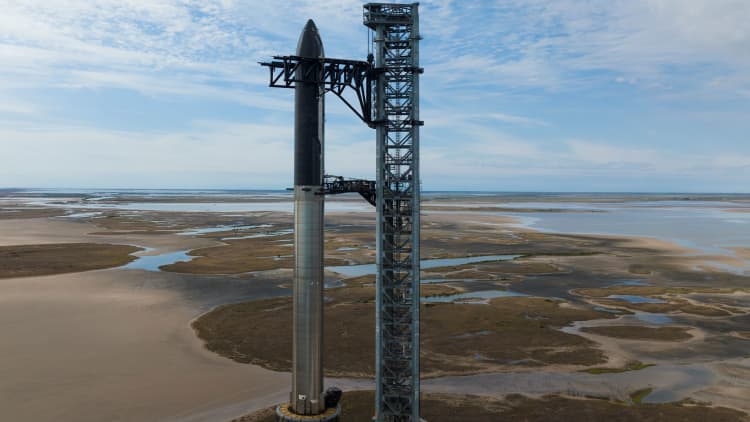
[ad_1]
SpaceX’s next-generation Starship spacecraft atop its powerful Super Heavy rocket is prepared for launch from the company’s Boca Chica launchpad on an uncrewed test flight, near Brownsville, Texas, U.S. November 15, 2023.
Joe Skipper | Reuters
SpaceX is set to make a second attempt at launching its Starship rocket to space on Saturday, with the company looking to push development of the mammoth vehicle past new milestones.
The company has a 20-minute window, from 8 a.m. to 8:20 a.m. ET, in which to launch Starship from its Starbase facility near Boca Chica, Texas. If SpaceX is unable to launch within that window for weather or technical reasons, the company will postpone the attempt to a later date.
SpaceX first launched a full Starship rocket system in April. Although that flight did not reach space, it successfully achieved multiple historic firsts for an experimental rocket of unprecedented scale. The mid-air destruction of the rocket, as well as an investigation into damage caused back on the ground, triggered a regulatory review that spanned nearly seven months.
The Federal Aviation Administration cleared SpaceX for a second launch attempt earlier this week.
Assuming the launch goes according to plan, Starship would reach space and then travel most of the way around the Earth before re-entering the atmosphere and splashing down off the coast of Kauai.
The launch attempt comes on the heels of renewed backlash against SpaceX CEO Elon Musk over comments made online. The White House on Friday condemned what it called “abhorrent promotion of Antisemitic and racist hate” by Musk on his social media platform, X.
Starship system
Starship is both the tallest and most powerful rocket ever launched. Fully-stacked on the Super Heavy booster, Starship stands 397 feet tall and is about 30 feet in diameter.
The Super Heavy booster, which stands 232 feet tall, is what begins the rocket’s journey to space. At its base are 33 Raptor engines, which together produce 16.7 million pounds of thrust – about double the 8.8 million pounds of thrust of NASA’s Space Launch System (SLS) rocket, which launched for the first time late last year.
Starship itself, at 165 feet tall, has six Raptor engines – three for use while in the Earth’s atmosphere and three for operating in the vacuum of space.

The rocket is powered by liquid oxygen and liquid methane. The full system requires more than 10 million pounds of propellant for launch.
The Starship system is designed to be fully reusable and aims to become a new method of flying cargo and people beyond Earth. The rocket is also critical to NASA’s plan to return astronauts to the moon. SpaceX won a multi-billion dollar contract from the agency to use Starship as a crewed lunar lander as part of NASA’s Artemis moon program.
Musk previously said he expects the company to spend about $2 billion Starship development this year.
Goals for second flight
There will be no people on board this attempt to reach space with Starship. The company’s leadership has previously emphasized that SpaceX expects to fly hundreds of Starship missions before the rocket launches with any crew.
SpaceX will be looking to surpass the nearly 4-minute flight of the first launch, reach space with Saturday’s attempt and demonstrate that improvements to its ground infrastructure mitigate the damage caused by the debut attempt.
During the April launch, SpaceX lit only 30 of the 33 Raptor engines at the base of the Super Heavy booster. Other engines were lost mid-flight. Additionally, a communications problem led to an unexpected delay in triggering the rocket’s Autonomous Flight Termination System, which destroys the vehicle in the event it flies off course.
SpaceX introduced upgrades to the launch pad infrastructure as well as the design of the rocket itself for the second attempt.

[ad_2]
Source link
